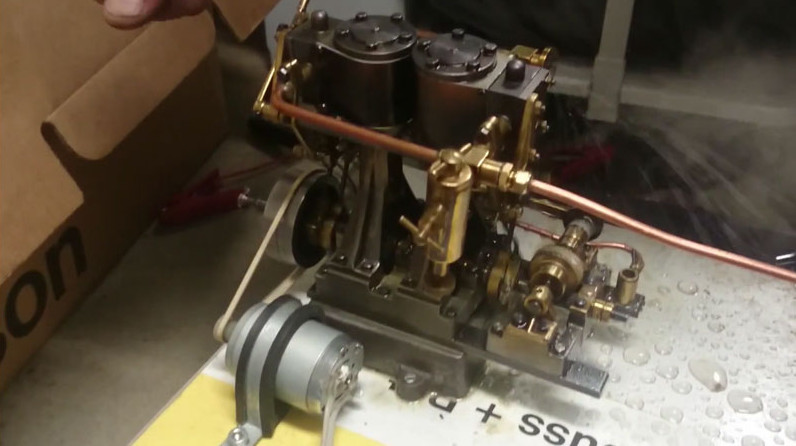Steampunk usually involves sticking a few old valves on your laptop and riding a penny farthing, but [Alexzpro] understands the real thing: he just created a steam powered Raspberry Pi Zero (translated).
His setup is a little lashed together, but works it’s a throwback to electricity generation of old and deserves the steampunk moniker. A steam boiler drives a steam turbine, which turns a motor, generating electrical power. This feeds into a regulator and a bank of capacitors that smooths the voltage out to a nice even 5 Volts, which powers the Pi.
It’s not exactly efficient, but running the steam boiler using two propane blowtorches sure makes us grin. Usually we see people trying to go the opposite direction and power their projects with renewables. We can appreciate this for what it is too, and it’s certainly not the first time we’ve see a Raspberry Pi burning through electricity for little apparent gain.
















To call this Steampuke implies that someone stuck some gears on a Raspi case. This has gone full on Metal.
Back of the napkin calcs would put efficiency of this below 10%, but hey…it works. The author’s face at the end says it all!
Nah, this is steampunk; it’s just proper steampunk. Gears stuck on a Pi-case is, like, Steam-teen-pop. Also, the video’s hit the bandwidth limit, so no-one can see it.
I guarantee you, efficiency is <1% if he is using two blowtorches to produce what, 5 watts tops of power?
A typical candle supplies 80 watts of thermal power, a blowtorch is probably close to 2 kW.
My plain cheap hardware store propane torch drinks about 1 lb/hr at full burn, so that’s around 5-6 kW.
Those look like butane canisters in the video. They might deliver half that power before freezing up so, yeah, 2-3 kW each.
On the upside, he’s built a very effective humidifier!
I do like that sweet looking engine. I wonder what that pump-like thing on the side is doing? Unused condensate pump? Oil pump?
da da da da da dat da!
Not a steam turbine. two cylinder vertical reciprocating engine with slide valves.
That’s not a steam turbine — that’s a twin cylinder steam engine, looks like it has sliding block valves. turbine wouldn’t have cylinders or valves.
a turbine would be more efficient, but I’m pretty sure that’s not the point of this project.
sometime I wonder if y’all deliberately put these sorts of errors in, to drawn reader engagement…
A Stuart Turner D10 ;-) I built a 10V (the single-cylinder version) from kit years ago – http://imajeenyus.com/mechanical/20050715_stuart_turner_10v/index.shtml
Not at this size and power it wouldn’t… Steam turbines are more efficient the reciprocating engines, BUT they have to be big, really big.
Use a 3 phase hobby motor and you will likely be able to drive a small display with it at that speed as well..
I agree. The setup as shown is probably WAY less than 10% efficient, with the bottleneck being that little motor being used as the generator. I’d say most of the power is lost in just turning the steam engine. A brushless DC motor made for serious power would be much better. Then you could run a whole Bitcoin farm of R-Pis with it!
No, most of the input heat power is lost because he’s running the thing at low temperature (so crappy Carnot efficiency) and open loop (no heat recovery at all).
Maybe use a stepper motor. They put out quite a kick although they are not as smooth to drive when under load. They don’t need to be driven as fast so gearing could come into play. Perhaps allowing for more than one motor to be used to generate the electricity.
i feel like cogging would be an issue with a stepper motor, though with enough torque i’m pretty sure it would work anyway.
Yeah, I agree.
And with a 3-phase bridge rectifier, you’ll be starting out with some pretty low ripple DC even before the smoothing caps.
I too often spend a few days or more without power, solar works great in summer but in cloudy and rainy winter where we already have a kerosene or propane heater and lanterns going I have wanted to do either a water boiling heat sunk TEG or steam motor (or a small propane generator). There are the Jensen model steam motors but I doubt they are big enough and are expensive. Does anyone know a reliable inexpensive motor and a good match generator or dynamo with enough capacity to kick out at least 10-15W over USB to get online with wireless and keep batteries charged between steaming?
Wouldn’t a sterling engine be better in this regard?
A Stirling engine might be “better” in the sense it can be more efficient than a steam engine at lower temperatures and pressures, doesn’t actually require steam, and can use the heat source directly.
“Better” in the sense of efficiency or power-to-weight would be to use an internal combustion engine and use that butane fuel directly.
Mad and so frigging cool! Love it. :)
Just wanted to say thanks to You all for giving this so much attention. It was a really fin project to build and won the schools best project of the year :) //Alexander Edvardsson aka Alexzpro :)
A bit late to add this but: the Stuart D10 produces a nominal maximum power of about one tenth of a horsepower, I think that’s about 75 watts, ample for a Raspberry Pi. The boiler needs to be able to deliver that, naturally. During WW2 the British produced miniature generator sets powered by the slightly larger Stuart Sirius engine and dropped them to Resistance fighters to charge radio batteries. Congratulations on your project Alex!
Would be more punk with a magnet reciprocating in a solenoid.